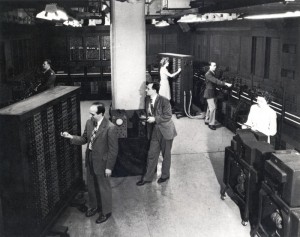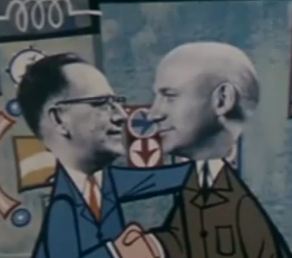Their Machine Launched a World of Change
Mission:
To inspire and support innovation by promoting the work of J. Presper Eckert and John W. Mauchly.  They created ENIAC, salve the first computer and the central icon of the computer revolution. The Foundation organizes and funds large scale projects for this aim.
Vision:
- The ENIAC website (the-ENIAC.com) will be an active information epi-center for the best available information on Eckert, order Mauchly, their computers ENIAC, EDVAC, BINAC, UNIVAC, and their lives.
- The ENIAC museum will be a unique visitor experience and a physical center for the celebration of the people and machines.
- The Eckert-Mauchly Center for Innovation will drive research and development in Computer and Information Science.
- Hack-ENIAC is a hackerspace, supporting non-institutional learning, sharing, and building electronics in the community.
Strategy:
- Leverage Web 2.0, the Internet as a group collaboration and communication tool, to build interest and to build the ENIAC website. Operate on a volunteer basis as long as necessary.
- Secure a partner for a bricks-and-mortar ENIAC museum. Work with the partner to develop a plan and provide fund raising for the effort. The partner could be he U. of Penn, the Franklin Institute, or the City of Philadelphia, or a corporation.
 Is man’s best friend still a dog? Or are you more likely to choose a laptop as your desert island companion?
Is man’s best friend still a dog? Or are you more likely to choose a laptop as your desert island companion?
Feb. 15 1946 is the day that ENIAC was shown to the world – and the world is still giddy with the trillion ways your life is better with a computer.
See today’s Philly Post:Â Happy Birthday ENIAC It’s a great overview of the ENIAC (and our fight to give it the respect it earned!)
Also new: Marty Moss-Coane on WHYY Radio Times did a nice hour program called The ENIAC Anniversary.  It featured an interview with Mitch Marcus from Penn and a few playful pokes at Jane Smiley, prescription who called in to try to defend her minority report.
Also: A Top TEN LIST in Technically
The Philadelphia Inquirer, ailment March 6, 2000
By Kay Mauchly Antonelli
They were a most unlikely pair. They met at the Moore School of Electrical Engineering of the University of Pennsylvania. My future husband, John Mauchly, was 34, had a Ph.D. in physics from Johns Hopkins University and had just completed eight years as head of the Physics Department at Ursinus College. J. Presper Eckert, 22, had just graduated from Moore School and had stayed on as an electronics lab instructor while beginning work on his master’s degree.
Before they left Moore in 1946, they had designed and built the world’s first electronic computer, ENIAC, and laid the basic design for all future electronic computers.
In the summer of 1941, Mauchly took a course called Emergency Science and Management Defense Training at Moore. The laboratory instructor was Pres Eckert. Mauchly, who had a lifelong dream of forecasting the weather, was hoping he could learn enough advanced electronics to help him with the design of a computer that could speed up his statistical analysis of weather phenomena.
He couldn’t have found anywhere a more receptive ear than Eckert’s. Despite his youth, Eckert was a genius in vacuum tube circuitry. He already had a patent in the television field. The two men spent most of their spare time exploring the possibilities of computing electronically.
When the course was completed in September, Moore School offered Mauchly a teaching position. Mauchly was happy to accept. It meant not only an increase in salary, but also an opportunity to explore with Eckert the possibilities of designing and building some sort of computer.
War was declared on Dec. 8. Within six months, the Ballistics Research Laboratory of Aberdeen Proving Ground had taken over the operation of the differential analyzer (the largest mechanical calculating machine in the world), which was in the basement of Moore. Aberdeen also established a computing laboratory there, for which they hired and trained about 100 women. These women, called “computors,” calculated trajectories to be used in Army firing tables. To compute only one trajectory, it took a computor 20 to 40 hours using an electric desk calculator.
Mauchly saw an immediate need for an electronic computer. In August 1942, he wrote a proposal titled “The Use of High Speed Vacuum Tube Devices for Calculating.” He envisioned an electronic computer that could computer a trajectory in 20 seconds.
This proposal finally came to the attention of a young Army mathematician, Lt. Herman Goldstine, who asked for a full proposal. Eckert and Mauchly worked night and day for several weeks writing up a proposal that the Army accepted on April 12, 1943. The proposed machine would be called ENIAC, an acronym for Electronic Numerical Integrator and Computer. It was understood from the beginning that this would be a general-purpose computer.
Eckert was chief engineer and Mauchly consultant in charge of logic and design. With the help and dedication of about a dozen engineers, numerous wise men and assemblers, ENIAC was built on the first floor of Moore School. It had 18,000 vacuum tubes, was 80 feet long and could operate at 100,000 pulses per second.
ENIAC was demonstrated to the public on Feb. 14, 1946. It was a huge success. The New York Times reported “an amazing machine which applies electronic speeds for the first time to mathematical tasks hitherto too difficult and cumbersome for solution.. . . Leaders who saw the device in action for the first time heralded it as a tool with which to begin to rebuild scientific affairs on new foundations.”
While ENIAC was being built, Eckert and Mauchly had many more ideas about how to build a smaller, cheaper, faster, more flexible machine, a stored program which they called Edvac. Forced out over a patent dispute, they left Moore School in March 1946 and formed their own company, Electronic Control Co., to build computers. Many of the engineers who had worked with them on ENIAC joined them.
Astonishingly enough, not a single bank or investment company was willing to lend them money. So with a loan of $25,000 from Eckert’s father and the enthusiastic support of engineers willing to work for next to nothing, the new company was launched. The government gave them a contract to build a computer for the Bureau of Census, which they called Univac. Douglas Aircraft contracted for a small computer called Binac. Eckert was chief engineer, and Mauchly was president and salesman.
The government took a chance, and soon they had contracts to build Univacs for the Army, Navy and Air Force. The company, now renamed Eckert and Mauchly Computer Co., soon attracted the attention of an investor, Henry Straus, who was willing to invest time and money.
Just when things seemed promising, the company suffered two massive blows. First, Straus was killed in a plane crash. Then the McCarthy investigations charged the company with employing engineers who had communist leanings. The company lost its clearance for government work; all contracts with the Army, Navy and Air Force were canceled. As president of the company, Mauchly was charged with hiring communists and ordered off the premises. He fought back, demanded a hearing, and after two years was allowed back on the premises. After intensive investigations, the only charge against Mauchly was that he was “eccentric.”
Meanwhile, the company, managing with a few civilian contracts and the Census Bureau contract, was sold to Remington-Rand, a manufacturer of punch-card equipment, typewriters and other office equipment. Eckert headed the engineering department, constantly developing new, faster and better methods for handling and storing data. Mauchly worked on machine languages and new programming methods. The two worked together all the time, with the dreamer Mauchly constantly coming up with ideas about what a computer should be able to do, Eckert constantly inventing hardware to make these things happen.
When his 10-year contract with Remington-Rand expired in 1960, Mauchly left to form his own company, Mauchly Associates, a construction management company. Eckert stayed with Remington-Rand as vice president of its Univac Division. Through its mergers with Sperry Corp. and later Burroughs, the company came to be called Unisys.
In 1971, Univac sued Honeywell for patent infringement. In the ensuing countersuit, the judge invalidated the ENIAC patents to Eckert and Mauchly, claiming, among other things, that the ENIAC was in public use more than a year before the patent was applied for. The testing of the machine by the Atomic Energy Commission was considered public use.
Eckert and Mauchly remained fast friends throughout their lives. They complemented each other. Mauchly was always the teacher – highly intelligent, witty and compassionate. Described by many as the “visionary of the computer age,” he was interested in developing people as well as ideas. Mauchly died in January 1980 from complications of an inherited blood disease. Speaking at Mauchly’s funeral in January 1980, Eckert said, “He inspired me and he inspired many others. He was not tied down by inhibitions or tradition. He was certainly one of the most brilliant people I ever knew.”
Eckert stayed with the company he had cofounded and retired as vice president of Unisys. This brilliant, original, no-nonsense engineer and spellbinding speaker died in 1995, just a few months before the 50th anniversary of ENIAC. In his later years, he had become a spokesman for the computer industry. He claimed in his speeches that he and Mauchly were the Wright Brothers of computing. He was honored by the IEEE, Institute of Electric and Electronic Engineers, as “Engineer of the Century.”
——————————————————————————–
Kay Mauchly Antonelli, one of the first women programmers on the ENIAC, was married to John Mauchly for 32 years. She died in 2006.
© 2000 Philadelphia Newspapers Inc.










